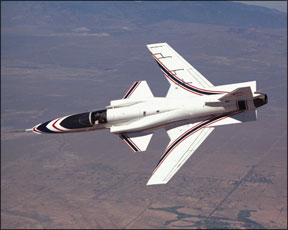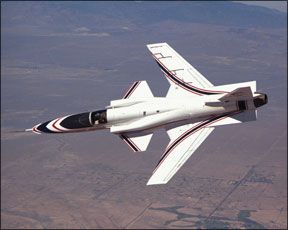The balancing act aircraft designers must achieve amazes me. Examples include trading useful load for a strong airframe, cabin volume for reduced drag and high cruise speeds for low-speed handling. And whenever handling stands out as an issue, its generally balanced against whether the airplane also shines in its stability-how, for example, it stays in the attitude we establish and resists any temptation of responding to gusts. Or, when we purposely upset a trimmed attitude, how it naturally tries to return to that attitude. Sure, its likely to “hunt” its way back to trim, but hopefully for just a couple of cycles. The designers 288 mastery always makes an airplanes nimbleness seem that much more impressive-especially if it goes where, how and when you ask, and seeks to stay put in between. Stability counts. But it counts differently for different machine types. Some, like the NASA X-29 research vehicle pictured above, are naturally unstable, and able to sustain controlled flight only through computer processing. In the now-retired X-29s case, computers continually adjusted the control surfaces up to 40 times each second. Others, like a jet transport, are optimized to resist any disturbance and can easily be flown with just two fingers. But any airplane can be made unstable, especially when we load it carelessly, or fly it beyond the regimes its designer intended. Where the average pilot should be concerned is in the many ways we can contribute to its loss of stability. Friend or Foe? It Depends If the airplane in question is optimized for aerobatic, as an example, its designers often seek near-neutral dynamic stability, balanced by powerful control authority and matched with eager responsiveness. This type of airplane goes where asked, when asked and acts as if the last attitude is the only one that counts. So it wants to stay put, not generally seeking a straight-and-level attitude. But for the airplane designed primarily as a teaching platform, excellent dynamic stability is paramount, offset with solid control feel and responsiveness of a much milder nature-all with control-force feedback communicating how far youre flying off the stability curve. We want that airplane to respond, to give the pilot useful feedback, but not be twitchy or demand overpowering control authority. And what about all those designs between these extremes? The Skyhawks and Skylanes, the Bonanzas and Comanches, the Mooneys and Cirri, and many more? Designers generally enjoy wide latitude in how they chose to balance stability with handling and response-that is, latitude within the limits of FAR Part 23. Those limits themselves have limits: Once certificated, each airplane comes with a set of limitations pilots must not exceed. What happens if you do exceed them is anyones guess, but loss of stability can be one outcome. Every time a standard aircraft levels off and achieves equilibrium between the four forces working on it, the pilot has tapped into the fifth element in aircraft forces, its stability. But even good, designed-in stability doesnt preclude pilots from upsetting an airplanes inherent characteristics to the point it becomes unstable. Forces for Stability Designers employ a variety of proven solutions to give an airplane design the desired stability while balancing its maneuverability. In the roll axis, for example, dihedral is a common design trait promoting stability. Look at an airplane, either nose- or tail-on: If the wings form a shallow “V,” its got dihedral. Measured in degrees, 1.5 to 5 degrees of dihedral isnt unusual. Angling the wings upward from their mounting point lowers the center of gravity in relationship to the lifting area. A a steeper “V” increases the desired effect. Anhedral, conversely, looks like a shallow inverted “V”-the wings angle downward, promoting roll responsiveness. Airplanes without anhedral or dihedral tend to be neutral in their roll stability. As an example, think the Extra 300, or others dedicated to competition aerobatics. The horizontal stabilizer-stabilator in the case of many Piper designs-provides required stability in the lateral axis, balancing the loaded airplanes center of gravity against the wings center of lift. The elevator-or, again, the entire stabilator in airplanes so equipped-provides pitch control to overcome that stability, with either a trim tab or anti-servo tab serving to relieve control pressures at whatever combination of attitude, speed and configuration the pilot chooses. Finally, theres little old yaw-the airplanes ability to pivot left and right around its vertical axis. The job of providing stability in this axis falls to the vertical stabilizer; the rudder provides the power to yaw. Dynamic Stability Most people who have flown unusual attitudes-or even just basic maneuvers-in an airplane with a wide, strong stability profile probably remember the experience as a result of sore muscles the next day. When flying a stable airplane in trimmed, 1G flight, the forces required to deviate in pitch increase the more you pull-or push down-the nose; ditto for the rudder. Yawing the tail full-rudder deflection to the right not only fights the airplanes innate stability, it also works against forces designed into it which seek to either straighten it out and/or roll it left. The farther the rudder pedal travels, the higher the force required to maintain that deflection. Roll, on the other hand, is a different story: In airplanes most of us fly, if we want a rapid roll rate, we must be willing to apply greater-than-normal force until the airplane actually rolls. Once that energy is imparted to the ailerons, the airplane will start rolling, only establishing a constant bank angle when we neutralize our input. Sometimes a little aileron input opposite the direction of roll is required to maintain the desired bank angle. Airplanes with little to no designed-in stability can exhibit some opposite traits. In such an airplane, control forces decline with deflection-or arent generally apparent at all; pitch pressures decline with speed-a dangerous situation. And the airplane can exhibit a tendency to diverge from stable flight once upset. Scary stuff, that-particularly in combination with other undesirable traits. Challenging Stability Even though the airplanes we fly most often are designed with stability in mind, those characteristics arent always available. Why? Its because pilots often do dumb things, things which may seem appropriate at the time but result in upsetting the airplanes designed-in stability. How do we relax an airplanes stability? By improperly using the few tools we have available, naturally. Those tools come in four basic types: weight, center of gravity, airframe ice and speed. It shouldnt come as a surprise to learn weight can upset stability, but you might be interested to know instability in pitch isnt the only manifestation. For example, on the Hershey-bar-winged PA-28 Piper Cherokees, burning too long off one wing tank can result in a wing imbalance. It can grow to the point of tiring the hand-flying pilot and taxing an autopilots roll servo beyond its ability to hold the airplane level. The solution is simple once you know and understand the issue: Establish and use a fuel-management pattern. A friend who switched to the Cherokee from an airplane with no such issues, originally held to the pattern of his prior plane: burning an hour off the first tank then two off the opposite. He quickly learned how heavy the opposite wing became when the strong roll imbalance overcame the clutch on his autopilots roll servo. He didnt enjoy the surprise roll. The same can happen when flying almost any airplane with wing-mounted fuel tanks. As you should be able to imagine, the effects are more pronounced when increased weight is placed further out on the wing, like with a full tip tank, for example. Meanwhile, every pilot who successfully completes primary training repeatedly faced weight-and-balance exercises, right up to and during the practical test. In many trainers and most training flights-including the “long” cross-country-starting a flight inside the CG envelope seldom created the possibility of it being outside the limits before the flight ends. Instead, its usually sometime after the checkride when a pilot discovers the practical implications of straying outside the CG envelope. Weve seen a few instances in which an end-of-flight forward CG condition left the airplane so nose-heavy that a full flare was impossible-and even more instances where fuel consumption created an aft CG beyond limits before the aircraft started final. And a final approach was too often the result, when the pilot lost pitch authority completely and the aircraft pitched over into a dive unrecoverable from low altitude. In other instances, an aircraft can be within CG-but at a forward or rearward limit-until the pilot slows the airplane too much and starts an uncoordinated turn. Predictably, the airplane then departs stable, controlled flight and can enter a spin. But because the CG is at an extreme, the airplane is slow to respond to the pilots recovery technique, even though the technique is proper and the airplane is within its certification limits. The spin is probably recoverable a few thousand feet up, but unrecoverable at pattern altitude and below since the airplane takes too long to respond at its present CG. Even if the CG is within limits at takeoff and landing, the excess weight of even relatively small amounts of ice challenges all the airplanes abilities and throw its limits out the window. The aerodynamic impact of the ice layer-essentially creating new camber and chord, twist and washout, all of which can drastically increase drag-quickly robs airfoils of their ability to generate effective lift. And as these pages discussed in April 2009 (“Icing And Tailplane Stalls”), tail icing can be worse than a badly out-of-aft CG problem by effectively raising the horizontal stabilizers stall speed to at or above approach speeds; get the iced-over horizontal stab or stabilator below its new stall speed and the airplanes occupants are in for a life-threatening ride. Of course, an iced-up tail also puts a bunch of weight where you dont need or want it, even if the tail remains above its stall speed. Finally, airspeed figures prominently in how pilots can reduce or eliminate a conventional airplanes stability. How? Ever notice the controls starting to feel soft and mushy while decelerating to land, practice slow flight or demonstrate a stall? One reason is the change in downforce the tail exerts (tailless, canard-based designs, for example, react differently). As airspeed drops, so does the amount of air flowing over the tail and the downforce generated, as demonstrated in the drawings at upper right. The wings downwash also affects how well the tail does its job at different speeds, at least with a conventional tail (T-tails need not apply here). Conclusion Any imperfection in the airplanes loading, configuration or handling can disrupt its designed-in stability. Presuming it was there to start with, of course. Most of the airplanes in the GA fleet come with a combination of features designed to make them easy to fly by even us mere mortals, but with sufficient flexibility for them to actually do something more than just straight-and-level cruising. All that goes out the window, though, when pilots do the things we do. When loading your airplane, planning a seats-filled cross-country flight, heading out for some airwork, or dealing with winter weather, think about the changes you might be making to its stability. Unless you really, really want to become an impromptu test pilot, make your loading and operational plans with the airplanes stability firmly in mind. Dave Higdon is a professional aviation writer/photographer and pilot with several thousand hours of flight time, many of which include known stability issues.




